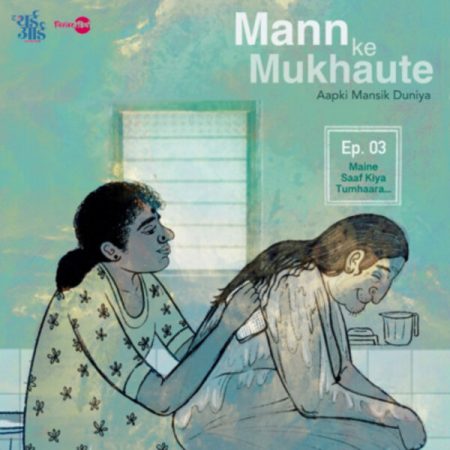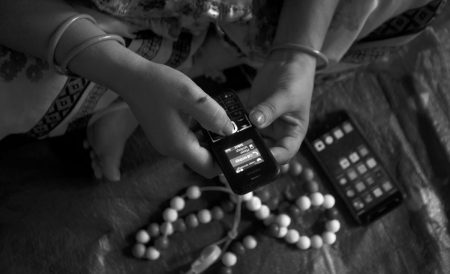In the first part of this report, we introduce a brief history of involving men in the gender programming of development and social sector in India, list reasons why men are presumed to have no interest in understanding gender, and explain how feminist spaces still hold value for them and their experiences.
Harjant Gill, a documentary filmmaker and scholar who has made multiple documentaries on Indian masculinity(ies), says, “One of the challenging things about talking about masculinity is that you engage men in this conversation and they don’t really know where to go with it, or like, how to even interrogate it… Clearly, they’re so empowered because of these kinds of power structures, they’ve never thought about it in a critical way. When I asked them questions about their turbans or their hair or their religion, they could give me a thesis on that. But, when I’d ask them about sexuality, gender and masculinity and what these meant to them, it was like pulling teeth to get them to that point.”
Catharsis is an important experience, but by itself, it is not a pedagogy. Work on masculinity cannot be limited to men coming together and making a ‘safe’ (a word made political by feminists) space for sharing and being vulnerable, without further reflecting on power and privilege. The reflection is also what makes this work on masculinity feminist. Otherwise, there is no difference between these workshops and the ones conducted by “Men’s Rights Groups”.
Neharika Mahajan, a senior trainer for gender and sexuality at Nirantar Trust, explains, “With men and boys, the facilitation challenge is to enable them to speak about their experience of loneliness and trauma, in ways where they also contextualise it and locate both their power and powerlessness.” Nirantar Trust has been doing gender training (unpacking gender and education) for three decades now, with everyone from corporate employees to NGO field workers. Neharika describes a workshop practice that is incorporated in all these training sessions. The first session is often about how gender is constructed and imposed from outside rather than from within. She says that this part is the easiest to facilitate, especially for men and boys who will readily articulate all the burdens laid upon them. The second session is about how one “does” gender. This is often facilitated through theatre practices where one uses their body and performativity to understand one’s own doing and performing of gender. This is where it becomes clear that when men do gender more or less successfully, they stand to gain quite a lot, which cannot be said for women of the same class and caste.
It is important to point out that (especially savarna) women, too, reinforce patriarchal structures in a variety of situations as the structure of brahmanical patriarchy does reward (or at least not punish) the women who uphold it. Thus, the solution is not to believe that all women (as if it is a monolithic group) are suffering and hence they are right all the time (as misogynistic caricatures of the women’s rights movement often claim). Patriarchy is rarely discussed with men and when it is, the discussion becomes entirely about its impact on women.
If the only way men understand patriarchy is from its impact on women, then that will comfortably separate them from the entire discourse. They can easily become “good men” by not committing violence against women.
The good man
It is crucial that patriarchy is spoken about as a structure and ideology that impacts men differently but equally. At the heart of the feminist analysis, contrary to popular understanding, is power, not gender. In workshops with girls and women, feminists have found it relatively easier to draw connections between their “everyday” or “personal” and patriarchy (the famous “personal is political”). But, how to do that with men and boys? How to make their “personal” political too? How does a facilitator help boys connect their everyday experiences to patriarchy? Akshat of Gender Lab answers, “Masculinity.” Masculinity is a big way in which the “political” of patriarchy becomes personal for them as an everyday experience. “When we start exploring certain aspects of masculinity and ask, ‘What is it for you?’ ‘Can you think of messages that are given at home, in school, or by media, to uphold certain masculine norms?’ Then they start questioning. ‘At home, I am told that I cannot cry and I am asked why I am shy. Or that I learnt to cuss because my dad does it at home.’ Toh I guess we try to explore it through that and not directly explain patriarchy and ask them to draw connections.”
If patriarchy is a force, gender norms are its foot soldiers. Masculinity, in particular normative masculinity, is its chief of staff.
For Anand Pawar, the executive director of SAMYAK in Pune, the question of masculinity and working with men emerged from a moment of crisis after conducting a massive family survey early on in his career. In 2001-2, 1700 families participated in an end-line evaluation survey where 80% of men scored very high on the gender sensitivity scale but in the same households, the women reported domestic violence. “I started questioning myself… I came up with these kinds of communication strategies and actually, I taught men the language of equality but didn’t really challenge their power relations. Then I personally understood that men do learn the language of equality very fast,” he remembers. Invariably, this led to a personal reflection. “It was not just a theoretical engagement. I was also going through a similar process because I started receiving this very acclaimed kind-of applause from people for being a gender-sensitive trainer.”
Thus, this performance of the “good man” comes easily to many men as they quickly learn how to adopt the language and symbols of equality.
Another symbol or performance of equality is public campaigning. Often, in such programming, one of the evaluation indicators is public action. Are the boys who were a part of a workshop able to initiate change in their community by designing a campaign or any such public activity? While this has an associated feminist history of creating collectives and solidarity in one’s own community and village, it does not necessarily work similarly with men because of their already existing claim to the public.
Having closely worked with the masculinity programming in his former role as the Executive Director of YP Foundation, Manak Matiyani laughs, “That is very easy. I need one day, that’s it. Give me one workshop. By the end of it, I will tell them, ‘Let’s do a campaign,’ and 1000 boys will stand up and say yes to it… [but that’s not the goal]. Outward action is easier than going inwards. The ability to reflect and say what these systems of power are doing to their own selves, the ability to express, the ability to say, ‘I don’t know’—these indicate the success of the workshop. The final goal is when that reflection becomes a habit.” What stepping out into the public place does for girls, stepping within and reflecting does for boys.
Violence beyond gender-based violence
Violence and masculinity are intrinsically connected so much so that even the “good men” are expected to be violent and aggressive in order to prove their goodness (Refer to popular films Jaane Tu Ya Jaane Na and Humpty Sharma Ki Dulhania).


For Akshat, making the boys understand what violence is has been an important strategy for them to start reflecting. “Helping them understand that even bullying is an act of violence or even using abusive language is an act of violence has proved useful,” he shares. Once the boys start unpacking the violence that they face in their own lives from older men, including their brothers, fathers, seniors and teachers, they start broadening the meaning of violence. Unless they understand the implications of the violence they experience, there is no way they can begin to understand the violence they might be imposing. This allows men to be able to address the violence that they face first before going ahead and “saving” women from violence.
This is significant because when advocacy around violence is limited to gender-based violence, it ends up invisibilising other forms of violence that many, especially men, experience on a daily basis. Manak says, “It is about communalism, it is about caste… it is about many other things. The agenda must be bigger than violence against women. Being violent is something that you’re continuously expected to do. And so if you are saying a rejection of violence, it is not just about violence against women, but it is about caste violence, religious violence, communal violence, all of those kinds of violence.”
“I hate all women”
Another big crisis for the facilitators and trainers is the resentment present among many men and boys against women.
Akshat observed this during his time in the classroom. “Boys feel like they aren’t getting enough as compared to girls. One big site of this is definitely the school where boys are beaten as punishment and girls aren’t. Teachers let go of girls more easily as compared to boys. Then, we see similar feelings in grown men about POSH (Prevention of Sexual Harassment Act) and #MeToo.” Another place from which resentment emerges is the “protection” of girls by their families. So, many times, the restrictions placed on girls’ freedoms are articulated as protection and care and their own freedom of movement is often understood as abandonment, where boys resent not feeling protected in the same way.
A boy told Nikhil of Yuvaa that a girl dumped him because he had once cried. How do we then communicate to men and boys that women are not the enemy? Harish of MAVA says, “The data of men’s suicides in our country is chilling. Men’s rights groups use it to claim that men’s lives are difficult and more treacherous because of women but I have to explain to them that that is not so. The data is very correct. But, it is not because of women but rather because of men’s inability to deal with failures and rejections in life.”
This is certainly not always easy when misogyny (especially in digital spaces) continues to pose young men against women at every step of the way. Nikhil says, “The net has made it quite clear in the last two years that it is going to push the loudest, angriest and most vile voices into the mainstream and a lot of those voices are misogynistic and homophobic. The culture is growing and there are Jordan Peterson-type people who are very much in the mainstream. In India, I can name 40 YouTubers and creators who are out there saying all kinds of shit things and it is scary to me because they are being consumed day in and day out. Ultimately, the algorithm will win over one conversation…”
Making of masculinity(ies)
One learning has been that other social locations play an important role in constructing masculinities, not only vis-a-vis women but between different men too. Manak argues that gender may only play one part in the construction of masculinity(ies). “Caste is a huge part of what constructs masculinity for boys. So, body image is connected to caste. Sexuality is connected to caste.” He shares an apocryphal anecdote. “I heard [someone say] recently that if a Rajput boy is gay, he must only be a top, not a bottom. Or in this focus group discussion with queer men, we also heard somebody say that wearing bangles is okay but they can’t wear make-up because of their caste location. Their body image, performance pressure—all of it is related to caste,” says Manak. This means that masculinity should perhaps be discussed in different kinds of programming and not only gender-related programmes. It’s also important to not equate men with masculinity. As masculine traits are rewarded and taken seriously in society, many women also perform and internalise them for different reasons as strategies. It is important to explore these while discussing the “doing” of gender for both men and women.
Kirthi Jayakumar is a peace educator and the founder of the Red Elephant Foundation, who has done extensive work with young children on sexuality, gender, and violence. She iterates the caste and masculinity connection. “Among upper-caste students, the markers of masculinity are very profoundly entrenched. They are expected to own their masculinity and behaviour. They are socialised into being loud and occupying space. So, if there’s a teacher calling for volunteers, they don’t put their hands up. They directly step up and walk to the front.”
There has been enough work on hegemonic masculinity and how it is a group of savarna, upper-class men who set the masculinity standards for others. But rarely does any advocacy or developmental sector work happen with them. As Abhijit of Centre for Health and Social Justice (CHSJ) vehemently argues, “Interest in masculinity is driven from a poverty perspective. It is always located in an anti-poverty framework. We haven’t looked at masculinity from where it is getting constructed. The big donors, in my experience, are only interested in working with the poor, but the rich men are setting up the models. In fact, we are all stuck in this anti-poverty framing because beyond the anti-poverty framing is the realm of the market.” As researcher Ketaki Chowkhani has discovered in her work too, consumption marks a lot of the romantic experiences for adolescent boys, whether it’s going out for movies, dinners, or even hanging around inside the space of a mall. One of the most significant characteristics of a “good man” is to be a breadwinner, making the market an important feature in the “crisis of masculinity”. The market performs a big role in thus constructing, reinforcing, and validating hegemonic masculinity.
Amongst these crises and dilemmas, it’s easy to forget the important conversations that have been generated by the concepts of masculinity and femininity. Neharika of Nirantar Trust points out, “If you take men and women out of the equation and just talk about femininity and masculinity, then that generates a lot of conversation and experience sharing. If you say men and women, there itself you will see a binary in the room where men will be quiet and resistant and women will be aggressive.”
Kirthi of Red Elephant Foundation, though, turns to a cogent call to action: “Forget pedagogy. Throw it out of the window. Go with knowing that you have privilege and you have power. Can you redistribute that power in ways that make every student a stakeholder in their learning journey? A stakeholder who is going to poke you as much as they are going to be poked by what you say. You don’t know anything. But deep listening is the only antidote to ignorance.”
(With inputs from Nirantar Trust’s Learning Resource Center)





